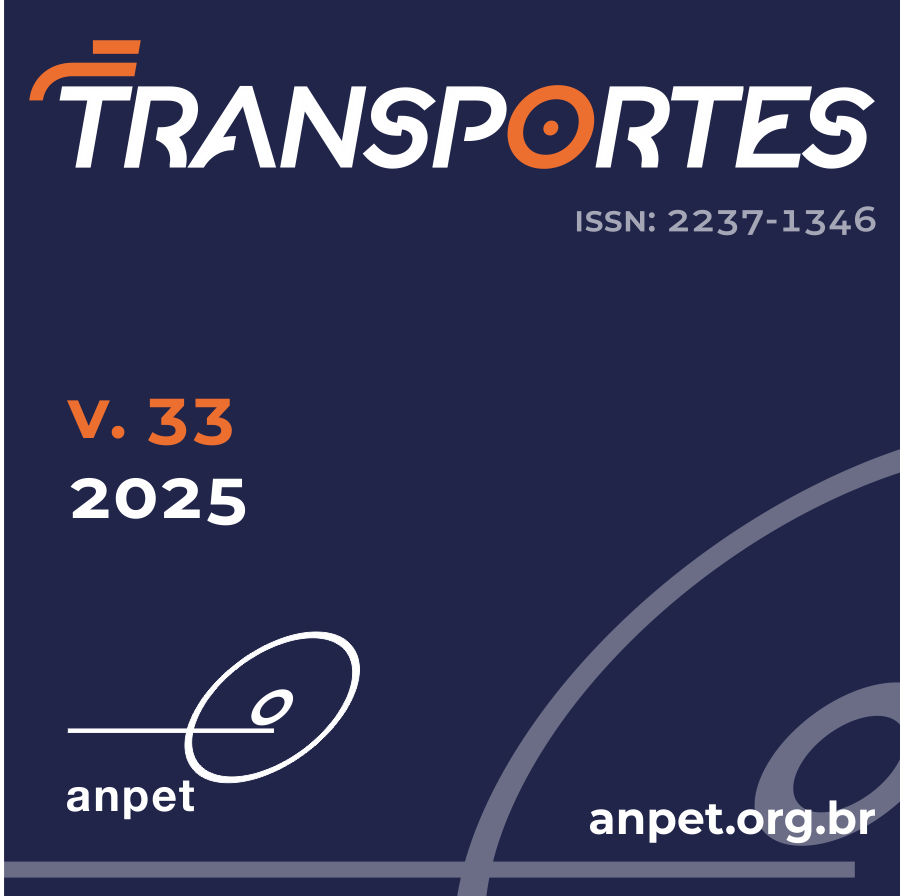Mobile phone use while driving indicators based on naturalistic driving data
DOI:
https://doi.org/10.58922/transportes.v33.e3053Keywords:
Driver distraction. Speed adaptation. Risk compensation.Abstract
The use of mobile phones while driving is a known risk factor for road crashes. Little is known about the characteristics of mobile phone use as a secondary task while driving in Brazil. The aim of this study was to derive road safety performance indicators related to mobile phone use while driving from Brazilian naturalistic driving data. The methodology involved an observational study analyzing video footage from 32 drivers in Curitiba and the Metropolitan Region. The most common type of use was checking/browsing: 44.96% of all instances. The average frequency of use was 8.71 uses per hour, with an average duration of 55.34 seconds per use. On average, drivers reduced their speed by 6.32 km/h after initiating use, and increased it by 5.11 km/h after completing the task. Checking/browsing was the type of use associated with the greatest speed adaptation, showing an average reduction of 7.39 km/h at the start, and an average increase of 3.55 km/h at the end. In conclusion, speed adaptation during mobile phone use was related to the complexity of the activity, based on the required manual, visual, and cognitive demands. However, drivers did not perceive the increased risk of making a call or sending a voice message, highlighting the need for more effective measures to reduce engagement in secondary tasks while driving.
Downloads
References
Atwood, J.; F. Guo; G. Fitch et al. (2018) The driver-level crash risk associated with daily cellphone use and cellphone use while driving. Accident; Analysis and Prevention, v. 119, p. 149-54. DOI: 10.1016/j.aap.2018.07.007. PMid:30031295. DOI: https://doi.org/10.1016/j.aap.2018.07.007
Backer-Grøndahl, A. and F. Sagberg (2011) Driving and telephoning: relative accident risk when using hand-held and hands-free mobile phones. Safety Science, v. 49, n. 2, p. 324-330. DOI: 10.1016/j.ssci.2010.09.009. DOI: https://doi.org/10.1016/j.ssci.2010.09.009
Bastos, J.T.; P.A.B. Santos; E.C. Amancio et al. (2020) Naturalistic driving study in Brazil: an analysis of mobile phone use behavior while driving. International Journal of Environmental Research and Public Health, v. 17, n. 17, p. 6412. DOI: 10.3390/ijerph17176412. PMid:32899144. DOI: https://doi.org/10.3390/ijerph17176412
Bastos, J.T.; P.A.B. Santos; E.C. Amancio et al. (2021) Is organized carpooling safer? Speeding and distracted driving behaviors from a naturalistic driving study in Brazil. Accident; Analysis and Prevention, v. 152, p. 105992. DOI: 10.1016/j.aap.2021.105992. PMid:33549972. DOI: https://doi.org/10.1016/j.aap.2021.105992
Christoph, M.; S. Wesseling and N. van Nes (2019) ‘Self-regulation of drivers’ mobile phone use: the influence of driving context. Transportation Research Part F: Traffic Psychology and Behaviour, v. 66, p. 262-272. DOI: 10.1016/j.trf.2019.09.012. DOI: https://doi.org/10.1016/j.trf.2019.09.012
Eldessouki, W. and A. Almaneea (2023) Smartphones and traffic signals: a quantitative assessment for phone usage behavior on performance of signalized intersections. Journal of Traffic and Transportation Engineering, v. 10, n. 4, p. 611-632. DOI: 10.1016/j. jtte.2022.06.005. DOI: https://doi.org/10.1016/j.jtte.2022.06.005
Funkhouser, D. and J. Sayer (2012) Naturalistic Census of Cell Phone Use, Transportation Research Record: Journal of the Transportation Research Board, v. 2321, n. 1, p. 1-6. DOI: 10.3141/2321-01. DOI: https://doi.org/10.3141/2321-01
IBGE (2019) PeNSE: Pesquisa Nacional de Saúde do Escolar. Rio de Janeiro: IBGE.
Ismaeel, R.; D. Hibberd; O. Carsten et al. (2020) Do drivers self-regulate their engagement in secondary tasks at intersections? An examination based on naturalistic driving data. Accident; Analysis and Prevention, v. 137, p. 105464. DOI: 10.1016/j. aap.2020.105464. PMid:32035295. DOI: https://doi.org/10.1016/j.aap.2020.105464
Khan, I.; S.S. Rizvi; S. Khusro et al. (2021) Analyzing drivers’ distractions due to smartphone usage: evidence from AutoLog dataset. Mobile Information Systems, v. 2021, p. 1-14. DOI: 10.1155/2021/5802658. DOI: https://doi.org/10.1155/2021/5802658
Kreusslein, M.; T. Morgenstern; T. Petzoldt et al. (2020) Characterising mobile phone calls while driving on limited-access roads based on SHRP 2 naturalistic driving data. Transportation Research Part F: Traffic Psychology and Behaviour, v. 70, p. 208-222. DOI: 10.1016/j.trf.2020.03.002. DOI: https://doi.org/10.1016/j.trf.2020.03.002
Morgenstern, T.; L. Schott and J.F. Krems (2020) Do drivers reduce their speed when texting on highways? A replication study using European naturalistic driving data. Safety Science, v. 128, p. 104740. DOI: 10.1016/j.ssci.2020.104740. DOI: https://doi.org/10.1016/j.ssci.2020.104740
Observatório Nacional de Segurança Viária – ONSV (2025) Estudo Naturalístico de Direção Brasileiro (NDS-BR). São José dos Campos.
Oviedo-Trespalacios, O.; M. Haque; M. King et al. (2018) Driving behaviour while self-regulating mobile phone interactions: a human-machine system approach. Accident; Analysis and Prevention, v. 118, p. 253-262. DOI: 10.1016/j.aap.2018.03.020. PMid:29653674. DOI: https://doi.org/10.1016/j.aap.2018.03.020
Phuksuksakul, N.; K. Kanitpong and S. Chantranuwathana (2021) Factors affecting behavior of mobile phone use while driving and effect of mobile phone use on driving performance. Accident; Analysis and Prevention, v. 151, p. 105945. DOI: 10.1016/j. aap.2020.105945. PMid:33385967. DOI: https://doi.org/10.1016/j.aap.2020.105945
Saifuzzaman, M.; M. Haque; Z. Zheng et al. (2015) Impact of mobile phone use on car-following behaviour of young drivers. Accident; Analysis and Prevention, v. 82, p. 10-19. DOI: 10.1016/j.aap.2015.05.001. PMid:26009990. DOI: https://doi.org/10.1016/j.aap.2015.05.001
Schneidereit, T.; T. Petzoldt; A. Keinath et al. (2017) Using SHRP 2 naturalistic driving data to assess drivers’ speed choice while being engaged in different secondary tasks. Journal of Safety Research, v. 62, p. 33-42. DOI: 10.1016/j.jsr.2017.04.004. PMid:28882275. DOI: https://doi.org/10.1016/j.jsr.2017.04.004
Tivesten, E. and M. Dozza (2014) Driving context and visual-manual phone tasks influence glance behavior in naturalistic driving. Transportation Research Part F: Traffic Psychology and Behaviour, v. 26, p. 258-272. DOI: 10.1016/j.trf.2014.08.004. DOI: https://doi.org/10.1016/j.trf.2014.08.004
Törnros, J.E.B. and A.K. Bolling (2005) Mobile phone use: effects of handheld and handsfree phones on driving performance. Accident; Analysis and Prevention, v. 37, n. 5, p. 902-909. DOI: 10.1016/j.aap.2005.04.007. PMid:15946638. DOI: https://doi.org/10.1016/j.aap.2005.04.007
Wijayaratna, K.P.; M.L. Cunningham; M.A. Regan et al. (2019) Mobile phone conversation distraction: Understanding differences in impact between simulator and naturalistic driving studies. Accident; Analysis and Prevention, v. 129, p. 108-118. DOI: 10.1016/j. aap.2019.04.017. PMid:31150917. DOI: https://doi.org/10.1016/j.aap.2019.04.017
Young, K.L. and M.G. Lenné (2010) Driver engagement in distracting activities and the strategies used to minimize risk. Safety Science, v. 48, n. 3, p. 326-332. DOI: 10.1016/j.ssci.2009.10.008. DOI: https://doi.org/10.1016/j.ssci.2009.10.008
Ziakopoulos, A.; A. Kontaxi and G. Yannis (2023) Analysis of mobile phone use engagement during naturalistic driving through explainable imbalanced machine learning. Accident; Analysis and Prevention, v. 181, p. 106936. DOI: 10.1016/j.aap.2022.106936. PMid:36577243. DOI: https://doi.org/10.1016/j.aap.2022.106936
Downloads
Published
How to Cite
Issue
Section
License
Copyright (c) 2025 Thiago Noriyuki Kubo, Arthur Hideio Noguti, Jorge Tiago Bastos

This work is licensed under a Creative Commons Attribution 4.0 International License.
Authors who submit papers for publication by TRANSPORTES agree to the following terms:
- The authors retain the copyright and grant Transportes the right of first publication of the manuscript, without any financial charge, and waive any other remuneration for its publication by ANPET.
- Upon publication by Transportes, the manuscript is automatically licensed under the Creative Commons License CC BY 4.0 license. This license permits the work to be shared with proper attribution to the authors and its original publication in this journal, and to be adapted for non-commercial purposes, provided appropriate credit is given and any derivative works are distributed under the same terms.
- Authors are authorized to enter into additional separate contracts for the non-exclusive distribution of the version of the manuscript published in this journal (e.g., publishing in an institutional repository or as a book chapter), with recognition of the initial publication in this journal, provided that such a contract does not imply an endorsement of the content of the manuscript or the new medium by ANPET.
- Authors are permitted and encouraged to publish and distribute their work online (e.g., in institutional repositories or on their personal websites) after the editorial process is complete. As Transportes provides open access to all published issues, authors are encouraged to use links to the DOI of their article in these cases.
- Authors guarantee that they have obtained the necessary authorization from their employers for the transfer of rights under this agreement, if these employers hold any copyright over the manuscript. Additionally, authors assume all responsibility for any copyright infringements by these employers, releasing ANPET and Transportes from any responsibility in this regard.
- Authors assume full responsibility for the content of the manuscript, including the necessary and appropriate authorizations for the disclosure of collected data and obtained results, releasing ANPET and Transportes from any responsibility in this regard.









